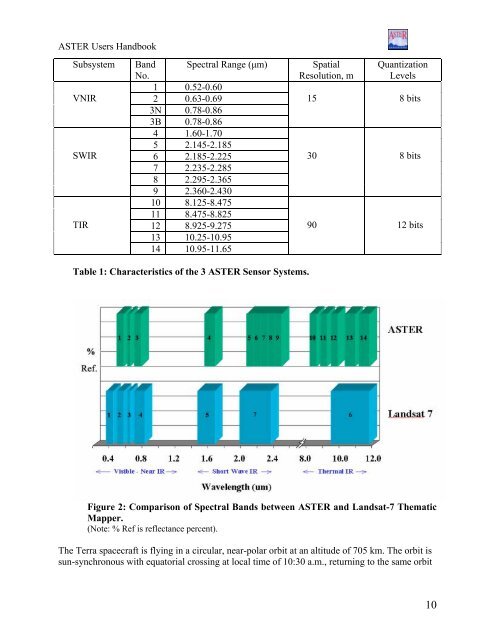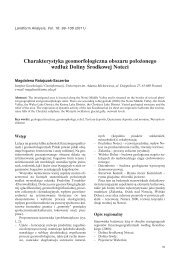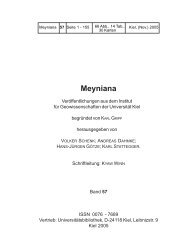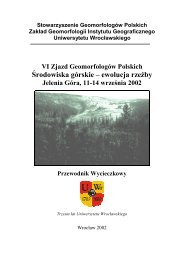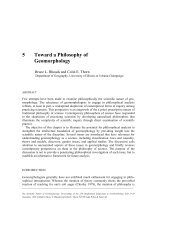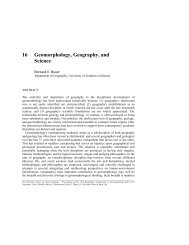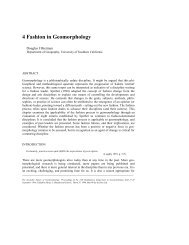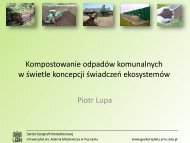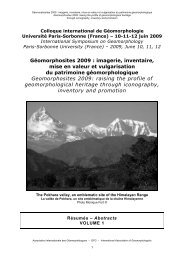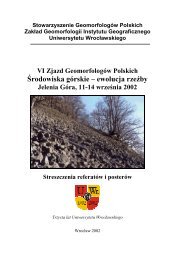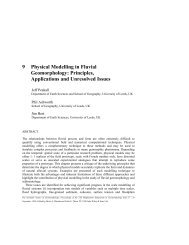- Page 2 and 3: ASTER Users Handbook ASTER User Han
- Page 4 and 5: ASTER Users Handbook Table of Conte
- Page 6 and 7: ASTER Users Handbook Table of Figur
- Page 8 and 9: ASTER Users Handbook 1.0 Introducti
- Page 12 and 13: ASTER Users Handbook Figure 3: VNIR
- Page 14 and 15: ASTER Users Handbook The scanning m
- Page 16 and 17: 3.0 ASTER Level-1 Data The ASTER in
- Page 18 and 19: Figure 6: End-to-End Processing Flo
- Page 20 and 21: ASTER Level-1A Users Handbook Data
- Page 22 and 23: ASTER Users Handbook ASTER Level-1B
- Page 24 and 25: ASTER Users Handbook 4.0 ASTER High
- Page 26 and 27: ASTER Users Handbook Band No. 1 2 3
- Page 28 and 29: ASTER Users Handbook Parameter Vers
- Page 30 and 31: ASTER Users Handbook • One-time c
- Page 32 and 33: ASTER Users Handbook Figure 9: Open
- Page 34 and 35: ASTER Users Handbook 3: Primary Dat
- Page 36 and 37: ASTER Users Handbook Figure 13: Dat
- Page 38 and 39: ASTER Users Handbook Figure 15: Cho
- Page 40 and 41: ASTER Users Handbook 9.0 ASTER High
- Page 42 and 43: ASTER Users Handbook Figure 17: Cup
- Page 44 and 45: ASTER Users Handbook Figure 19: AST
- Page 46 and 47: ASTER Users Handbook 156 km 3 . The
- Page 48 and 49: ASTER Users Handbook wind direction
- Page 50 and 51: ASTER Users Handbook Figure 24: AST
- Page 52 and 53: ASTER Users Handbook Figure 26: Nea
- Page 54 and 55: ASTER Users Handbook 12.0 Geo-Refer
- Page 56 and 57: ASTER Users Handbook 12.3 ASTER Lev
- Page 58 and 59: ASTER Users Handbook Figure 29: AST
- Page 60 and 61:
ASTER Users Handbook OBJECT = Dimen
- Page 62 and 63:
ASTER Users Handbook 13.0. Frequent
- Page 64 and 65:
ASTER Users Handbook correction coe
- Page 66 and 67:
ASTER Users Handbook 15: Production
- Page 68 and 69:
ASTER Users Handbook ASTER Level-1
- Page 70 and 71:
ASTER Users Handbook overpass then
- Page 72 and 73:
ASTER Users Handbook ImagePixel Dim
- Page 74 and 75:
ASTER Users Handbook Projection Par
- Page 76 and 77:
ASTER Users Handbook Blackbody Temp
- Page 78 and 79:
ASTER Users Handbook Outer G-Ring I
- Page 80 and 81:
ASTER Users Handbook Sensor (Bands)
- Page 82 and 83:
ASTER Users Handbook Produced on-de
- Page 84 and 85:
ASTER Users Handbook (Production Da
- Page 86 and 87:
ASTER Users Handbook Y. YAMAGUCHI,
- Page 88 and 89:
ASTER Users Handbook ASTEROPERATION
- Page 90 and 91:
ASTER Users Handbook OFFSET4= -0.21
- Page 92 and 93:
ASTER Users Handbook AVGCORRELCOEF9
- Page 94 and 95:
ASTER Users Handbook CORINTEL14= "C
- Page 96 and 97:
ASTER Users Handbook Decorrelation
- Page 98 and 99:
ASTER Users Handbook Brightness Tem
- Page 100 and 101:
ASTER Users Handbook Surface Reflec
- Page 103 and 104:
ASTER Users Handbook Surface Radian
- Page 105 and 106:
ASTER Users Handbook Surface Radian
- Page 107 and 108:
ASTER Users Handbook Surface Emissi
- Page 109 and 110:
ASTER Users Handbook Surface Kineti
- Page 111 and 112:
ASTER Users Handbook This ASTER pol
- Page 113 and 114:
ASTER Users Handbook research inclu
- Page 115 and 116:
ASTER Users Handbook Attribute Name
- Page 117 and 118:
ASTER Users Handbook formatted_prod
- Page 119 and 120:
ASTER Users Handbook level_1_carryo
- Page 121 and 122:
ASTER Users Handbook level_1_carryo
- Page 123 and 124:
ASTER Users Handbook formatted_prod
- Page 125 and 126:
ASTER Users Handbook level_1_carryo
- Page 127 and 128:
ASTER Users Handbook formatted_prod
- Page 129 and 130:
ASTER Users Handbook UTMZONECODE13
- Page 131 and 132:
ASTER Users Handbook Appendix IV: P
- Page 133 and 134:
ASTER Users Handbook Appendix V: LP
- Page 135:
ASTER Users Handbook DATA CENTER De


